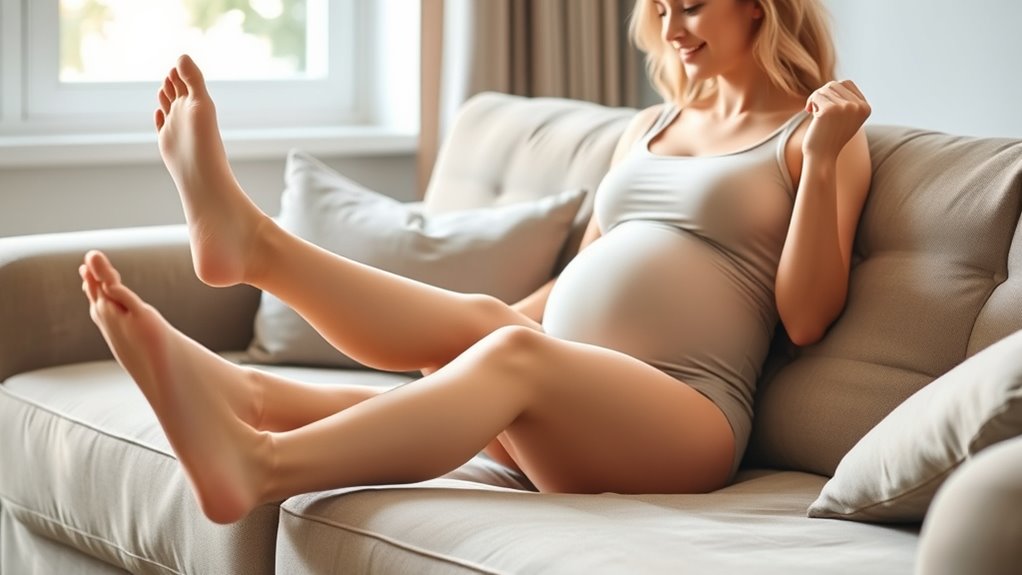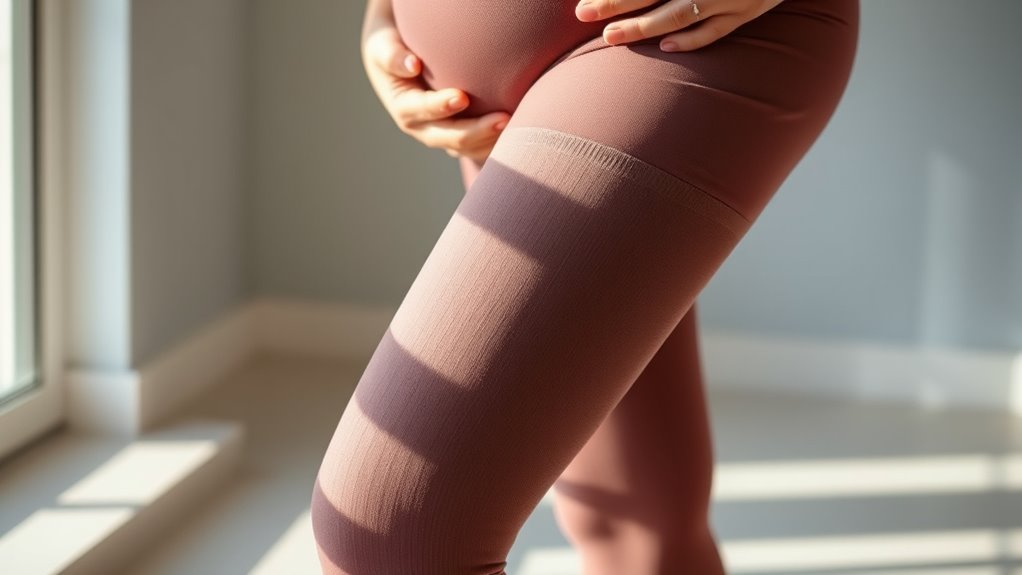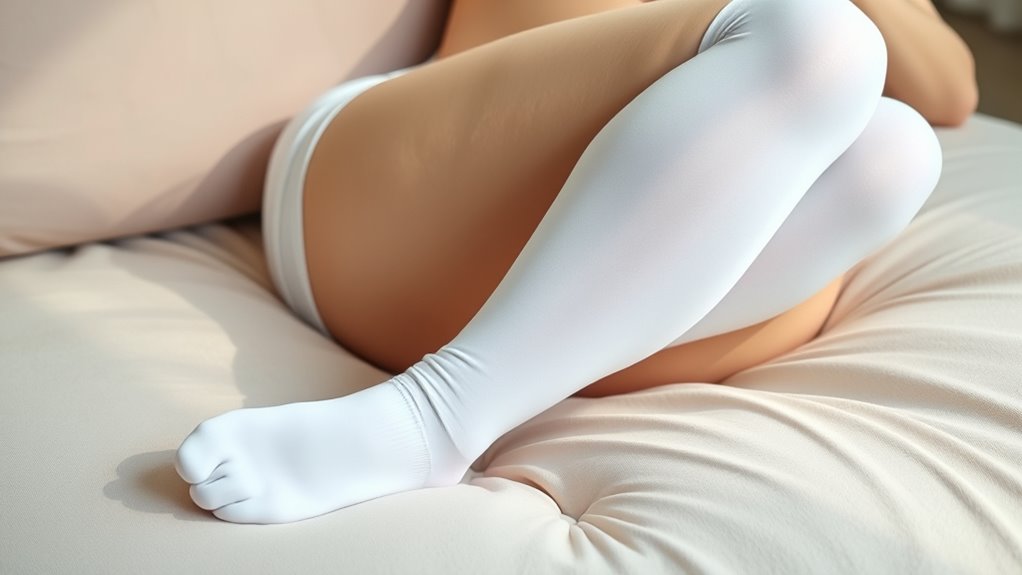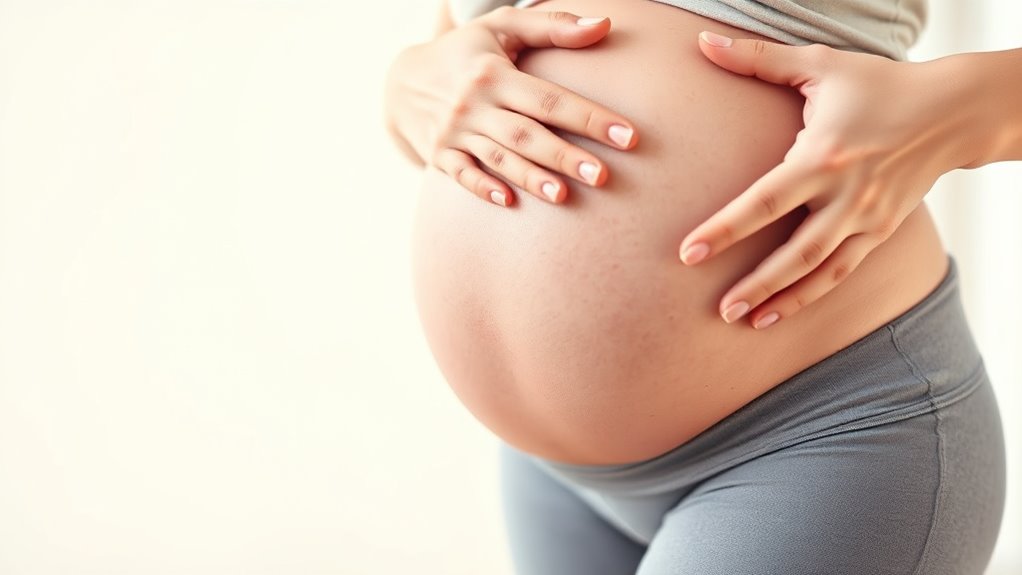Pregnancy swelling occurs due to excess fluid buildup, hormonal changes, and increased blood volume, which can slow circulation and cause discomfort. Graduated compression stockings help by applying gentle pressure that improves blood flow, supports veins, and reduces fluid pooling in your legs. This helps lessen swelling, relieve heaviness, and prevent issues like varicose veins. To understand how to choose the right stockings and stay safe, discover more about effective strategies to keep your legs comfortable.
Key Takeaways
- Graduated compression stockings apply pressure that supports veins and enhances blood flow from legs to the heart.
- They prevent blood pooling in lower limbs, reducing swelling and discomfort during pregnancy.
- Compression improves circulation, decreasing fluid leakage into tissues and alleviating edema.
- Properly fitted compression garments help minimize the risk of varicose veins and blood clots.
- Combining compression with elevation and exercise optimizes swelling reduction and overall leg health.
Understanding the Causes of Swelling During Pregnancy

During pregnancy, swelling occurs when excess fluid builds up in your tissues, often in the legs, ankles, and feet. Hormonal changes play a significant role in this process, as increased levels of hormones like progesterone cause blood vessels to relax and become more permeable. This relaxation allows fluid to leak into surrounding tissues, contributing to swelling. Additionally, pregnancy puts extra pressure on your circulatory system because your blood volume increases to support your growing baby. This heightened volume slows blood flow and causes fluid to accumulate in your lower extremities. The combination of hormonal shifts and circulatory changes makes swelling more common during pregnancy, especially later on, as your body adapts to these physical and hormonal adjustments. Some research also suggests that sound healing science may influence bodily functions and promote relaxation, potentially aiding in managing pregnancy discomforts.
How Graduated Compression Stockings Work to Reduce Swelling

Graduated compression stockings are designed to apply gentle pressure to your legs, helping to improve blood flow and reduce fluid buildup. By applying the highest pressure at your ankles and gradually decreasing up your legs, they support your veins and promote efficient blood return to your heart. This targeted pressure prevents blood from pooling in your lower limbs, which is a common cause of swelling during pregnancy. The improved blood flow reduces fluid leakage into surrounding tissues, easing swelling and discomfort. Plus, the vein support provided by these stockings helps maintain healthy circulation, preventing varicose veins and other circulation issues. Wearing graduated compression stockings regularly encourages your body to move blood more effectively, keeping swelling under control and supporting your overall leg health during pregnancy. Additionally, using compression therapy can be an effective strategy to enhance circulation and reduce swelling further.
Benefits of Using Compression Stockings for Expectant Mothers

Wearing compression stockings offers expectant mothers numerous benefits, particularly in reducing swelling and discomfort. These stockings enhance compression therapy, promoting better circulation and easing pressure on your legs. As a result, you’ll experience less aching and fatigue, making daily activities more comfortable. Using compression stockings can also help prevent varicose veins and blood clots during pregnancy. To understand how they work, consider this table:
| Benefit | How It Helps | Why It Matters |
|---|---|---|
| Circulation Improvement | Boosts blood flow to legs | Reduces swelling and pain |
| Swelling Reduction | Limits fluid buildup | Keeps legs lighter and comfortable |
| Discomfort Relief | Eases aching and heaviness | Enhances daily comfort |
Investing in proper compression stockings supports your health and comfort during pregnancy.
Tips for Choosing the Right Compression Garments

Choosing the right compression garments can make a significant difference in managing pregnancy swelling, so it’s important to select options that fit well and provide the appropriate level of compression. When making your choices, consider your fashion options—look for styles that suit your wardrobe and comfort needs. Material considerations are also essential; opt for breathable, stretchy fabrics that wick away moisture and reduce irritation. Make sure the garment fits snugly without being too tight, as poor fit can reduce effectiveness and cause discomfort. Additionally, choose compression levels suitable for pregnancy stages, and avoid overly constrictive options. Prioritize comfort and convenience, and select designs that you’ll feel confident wearing throughout your day. Proper fit and thoughtful material choices ensure maximum benefit and comfort. For optimal results, consider tuning your compression garments to match your evolving needs during pregnancy.
Safe Practices and When to Consult a Healthcare Provider

Selecting the right compression garments is important, but it’s equally vital to guarantee their use remains safe throughout your pregnancy. Always follow your healthcare provider’s guidance on proper fit and duration of wear. If you experience increased swelling, pain, or skin changes, stop using compression garments and consult your provider promptly. While alternative remedies like elevation, gentle exercise, and lifestyle modifications can help manage swelling, they shouldn’t replace medical advice. Keep an eye out for symptoms such as sudden swelling, severe pain, or shortness of breath, which require immediate medical attention. Regular check-ins with your healthcare provider ensure your swelling management remains safe and effective. Trust their expertise to determine when additional interventions might be necessary for your health and comfort. Incorporating hydrotherapy techniques, when approved by your healthcare provider, can also provide soothing relief for pregnancy-related swelling.
Additional Strategies to Manage Swelling Effectively

To manage swelling effectively during pregnancy, incorporating simple lifestyle changes can make a significant difference. Regular exercise routines, like walking or prenatal yoga, improve circulation and reduce fluid buildup. Be sure to move gently and consistently, avoiding prolonged sitting or standing. Dietary adjustments also play a role; reducing salt intake can prevent water retention, while staying well-hydrated helps flush excess fluids. Elevate your legs whenever possible to promote circulation and lessen swelling. Wearing comfortable, supportive footwear and loose clothing can prevent unnecessary pressure. Avoid tight accessories that restrict blood flow. These small but consistent changes support your body’s natural processes, helping you manage swelling more comfortably and safely throughout your pregnancy. Additionally, exploring local dining options that emphasize fresh, seasonal ingredients can support a healthy diet during this time.
Frequently Asked Questions
Can Pregnant Women Wear Compression Stockings During the First Trimester?
You can wear compression stockings during early pregnancy if you experience swelling or discomfort, but it’s best to consult your healthcare provider first. Hormonal changes in the first trimester can affect your circulation, so compression stockings may offer relief. Choose graduated compression stockings specifically designed for pregnancy, and make certain they fit properly to avoid constriction. Always follow medical advice to safely support your circulation during early pregnancy.
Are There Any Risks Associated With Wearing Graduated Compression Stockings?
Did you know that improper use of compression stockings can lead to issues like reduced circulation or skin irritation? Risks assessment is vital before wearing graduated compression stockings, and ensuring proper fitting is essential. If they’re too tight or ill-fitting, they might do more harm than good. Always consult your healthcare provider to evaluate potential risks and confirm the right size, so you stay safe and comfortable.
How Long Should Expectant Mothers Wear Compression Stockings Each Day?
You should wear compression stockings according to your healthcare provider’s compression schedules, which often recommend wearing them for most of the day, typically 8-12 hours. Guarantee your stocking fit is snug but not too tight to avoid discomfort or circulation issues. Adjust your schedule based on activity levels and comfort, and remove them at night or during long periods of rest to promote healthy blood flow and prevent swelling.
Can Compression Garments Be Used Alongside Other Swelling Relief Methods?
Imagine you’re trying to reduce swelling effectively, and you’re wondering if compression garments can work with other methods. Yes, they can be part of an extensive plan that includes complementary therapies like gentle leg exercises and lifestyle adjustments such as elevating your legs. Combining these approaches helps improve circulation and reduce swelling more efficiently, giving you relief. Always consult your healthcare provider to ensure all methods are safe for your pregnancy.
Are There Specific Brands or Types of Compression Stockings Recommended for Pregnancy?
When choosing maternity compression or specialized stockings for pregnancy, look for reputable brands that offer medical-grade compression. You should pick stockings with graduated compression, which applies the most pressure at the ankle and less as it moves up your leg. Brands like Sigvaris, Juzo, or Mediven are popular options. Guarantee the fit is comfortable and consult your healthcare provider for personalized recommendations to effectively reduce swelling.
Conclusion
By embracing the gentle support of graduated compression stockings, you can help ease the natural swelling that comes with pregnancy. Think of them as a caring embrace for your legs, making each step a little lighter. When combined with mindful habits and your healthcare provider’s guidance, you’ll find it easier to navigate this beautiful journey. Remember, a little extra comfort can make all the difference, helping you stay confident and radiant every day.









